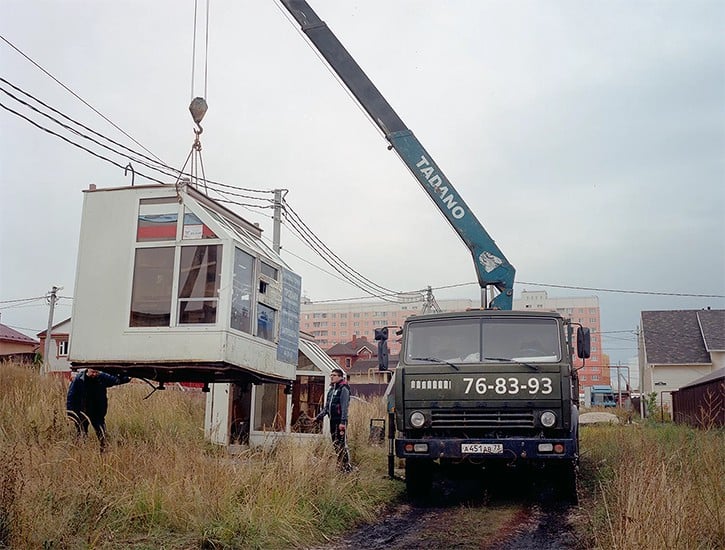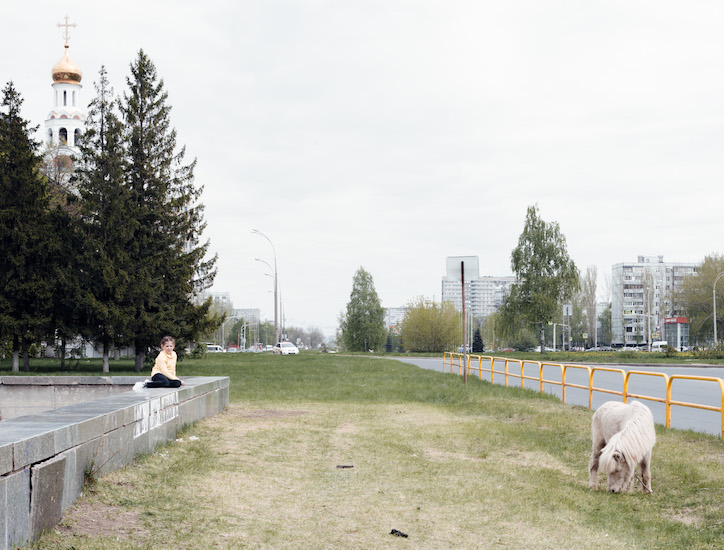Repurposing Utopia
Two photobooks chart the afterlife of Soviet architecture From "Infrastructures." | Sergey Novikov and Max Sher
From "Infrastructures." | Sergey Novikov and Max Sher o
r
d
F
a
c
t
o
r
y
Michele Cera and Guido Sechi, Tolyatti: Exploring Post-Soviet Spaces.Velvet Cell and V-A-C Foundation, 116 pages.?
Max Sher and Sergey Novikov, Infrastructures: Power, Property and Territory in the Post-Soviet Space.RecurrentBooks, 360 pages.
In 2011, the French photographer Frédéric Chaubin published CCCP: Cosmic Communist Constructions Photographed, a glossy coffee table book showcasing Space-Age Soviet Architecture. It ushered in a trend that continues a decade on; London Sovietophile publishers FUEL have since brought out photobooks on Soviet Bus Stops, Sanatoriums, Lenin statues, and Metro Stations. The genre’s tropes have extended to the point where photographers no longer feel compelled to travel to the former Union of Soviet Socialist Republics. FUEL recently published Soviet Signs and Street Relics by Jason Guilbeau, composed entirely via exploring Google Street View, without the author leaving France.
“The majority of photographic books on socialist architecture are characterised by evidently orientalist rhetorical devices,” writes the urban historian Guido Sechi. This approach sets up “the otherising image of a lost and threatening totalitarian civilisation,” which is detached from the present and presented as a series of alien, cosmic ruins—an image of failure and disaster or of utopian longing or both. A crucial move here is the removal “of real people from the landscape,” which elides the fact that most Soviet spaces are still inhabited, used, and often modified by their users. (This is surely one reason why actualabandoned ruins, such as the Buzludzha Monument in Bulgaria, or the poisoned town of Pripyat, near the Chernobyl atomic power station, have received particular attention.) It also mirrors the economic logic of clearance and property development. One photographer’s ruined space-age utopia is somebody else’s block of flats. From the Narkomfin building in Moscow to Park Hill in Sheffield, ruination and architectural celebration often serve as the precursor to a building’s refashioning as a privatized “iconic” work, denuded of any poor inhabitants.
Most Soviet housing was subject to “instant privatization” in the early 1990s, with the state retaining ownership over land while handing over flats to residents.
Two new photobooks provide an alternative to these decontextualized images, ripped out of any engagement with politics, history, or actual human beings. Each uses photography and commentary to reflect on what it means to live in a capitalist country which has, in living memory, been the site of an attempt to completely reorganize society along non-capitalist lines. The Italian duo of Sechi and Cera consider the single-industry planned city of Tolyatti, outside Samara in central Russia. The Russian pair of Max Sher and Sergey Novikov attempt something more ambitious, sketching an entire political economy of post-Soviet Russia through architectural images.
Tolyatti: Exploring Post-Soviet Spaceshas its fair share of the Tarkovsky picturesque: Cera’s first photograph is of grey factory chimneys framed by untamed, overgrown trees. But while the book criticizes “visual narratives committed to the tropes of lifeless monumentality and alien logic,” it also historicizes the place where these buildings went up. To that end, Sechi discusses the founding of this company town in the village of Stavropol-on-Volga after the Second World War, stressing the crucial role of the “West,” in this case, his native Italy. In a curiously paradoxical formation, the new town was named after the Italian Communist leader Palmiro Togliatti, while the car factory and the cars it produced were co-designed with FIAT. The Avtozavodskaya District that housed the workers ?was planned in the 1960s by Samara-born Boris Rubanenko, who drew on the USSR’s Constructivist heritage as well as international exemplars such as Brasilia. This was not an autarchic enclave at the edge of the world or an alien civilization, but something very much part of the global trends of the time. It also declined when other, similar places did. The oil crisis of the mid-’70s and the sharp recession that followed ensured that the district’s central House of Culture, Art and Creativity (DKIT) did not open until the 1980s, more than a decade after it was planned.
Most Soviet housing was subject to “instant privatization” in the early 1990s, with the state retaining ownership over land while handing over flats to residents. Cera attends to the stress of inhabitation and adaptation, and the visual results are pungent: from air-conditioning units to large, cantilevered self-built balconies—a major feature of the region, showcased last year in Oleksandr Burlaka’s hilarious and beautiful photobook Balcony Chic. People are shown eating and drinking and partying in their flats and in still-public buildings like the House of Culture; they swim at a leisure center below a grand modernist mosaic; in short, they live a normal life, though the specificity of the landscape is not ignored. In one of the most striking images, a young girl sits on a grand granite plinth on a modernist boulevard, near which a horse nibbles at the surrounding lawn. New buildings are rare, aside from the kiosks of semi-formal commerce. Most common are recently built Orthodox churches, in simple, kitsch reproductions of historic Russian architecture. Looked at carelessly, Cera’s photographs—of, say, housing blocks in sunset, with the green plains of the Russian countryside coming right up to the concrete panels—might resemble one of those oft-shared images of Pripyat. But the book is telling a more complex story.
As are the writer-photographers Sher and Novikov. Rather than simply depict a few buildings, they set out to document a particular civilization, creating a sort of visual-textual bestiary of Russian capitalism. Their book surveys the entire post-Soviet territory apart from the Baltic States, with excursions to the Caucasus, Ukraine, Siberia, and Central Asia—though Russia remains its dark heart. They frequently use reconstruction, panorama, and satire, constructing images rather than just depicting what is in front of them. Their photography is on a different level to anything you’ll find in most Soviet architecture photobooks—with a rare degree of creativity, humor, and critical venom.
Sher and Novikov believe that capitalism in Russia is just another variant of the “Oriental Despotism” that has plagued the country throughout history, determined by a “patrimonial” system of land ownership and ultra-centralized power. Such ideas have been advanced at various times with various emphases by thinkers as diverse as Leon Trotsky, the right-wing historian Richard Pipes, and the Sinologist and Marxist-turned-McCarthyite Karl Wittfogel—though the essentialism of this theory has of-late been called into question. The authors sometimes acknowledge the implicit racism of “Oriental Despotism,” admitting that contemporary Russia displays the forms of corruption, poor infrastructure, and inequality seen in capitalist states everywhere except for Scandinavia and parts of North-Western Europe. All the same, they set out to prove this argument with images of land uses, building types, and forms of planning, from the borders of China to the those of Finland; their examples range from eighteenth century panoptic villages to contemporary real estate boondoggles.?
Infrastructuresis a passionate and highly intelligent exercise in what Isaac Deutscher called “national nihilism”
Semi-ironically inspired by the example of Socialist Realism—which demanded that artists show not just what is, but what will be—Sher and Novikov document “what exists but is invisible.” The list includes a road leading to a factory in Rostov that nobody has owned for twenty-five years; a forest destroyed by parasites introduced in a process of clean-up for the Sochi Olympics; dozens of surviving statues of the assassinated Bolshevik leader Sergei Kirov; egregious examples of the national kitsch that became mandatory to celebrate “The Friendship of Peoples” both in the USSR and in contemporary Russia’s spurious federalism; massively over-engineered bridges to nowhere in particular; the Institute of Scientific Information on Social Sciences Library in Moscow, a privileged site of free access to information for the technical intelligentsia and Nomenklatura, destroyed recently in what was surely a property scam in an area of sharply rising land values; Houses of Culture that became gangland bases in the 1990s; pipelines, generators, and other spaces of extraction, some of them visibly being siphoned off from by local communities and organized crime; the small democratic enclaves of dacha colonies; outposts of the corrupt church, which is now effectively a property developer far more concerned with consolidating its land holdings than with restoring the historic buildings it owns; and, most of all, spaces of enclosure and gating, with high walls protecting the elite from everyone else.

Where Tolyattiacknowledges the continued use (and usefulness) of Soviet infrastructure, Infrastructurespresents a picture of immense waste and foolishness. Sometimes, this is overstated. For instance, Sher and Novikov appear to think that the mining towns established in the Arctic Circle (rapidly depopulating, and beautifully photographed here) were gratuitous and useless. But extremely unpleasant as they were and are, these towns were integral to an advanced and powerful military-industrial complex. More generally, a state that was responsible for major inventions and achievements, from satellites to computing, and comprehensively rehoused a population of tens of millions in a couple of decades after the gigantic destruction of the Second World War, can’t be entirely dismissed as an enormous exercise in deception and propaganda.
But even when they overreach, Sher and Novikov put forward a very different explanation for Soviet architectural “failure” to that found in most photobooks. Here, it isn’t the overarching crazy utopian ambitions of the Soviets that caused such misery, but an endemic fear of the masses, a reliance on centralized power, an unbreakable system of jobs-for-the-boys, and the effects of historic poverty—a more mundane and much more convincing argument. They also provide an alternative to recent accounts by the likes of Anne Applebaum or Timothy Snyder, who see Putin’s rule as some sort of return to Stalinism. As they note in an account of Russia’s breakneck privatization in the early 1990s:
There is still neither a strong state nor law and order in Russia, but bandit-bureaucratic capitalism is flourishing . . . An even narrower group of elites [rules] than under the USSR—though now on more “rational,” semi-market terms, without the welfare state and other burdens.
Yet there is no room here for the more sympathetic insights of scholars such as Michal Murawski and Kimberly Elman Zarecor, who argue that significant amounts of the built environment in former state socialist countries remain meaningfully “still-socialist,” functioning as public goods, enjoyed and prized by their residents and users. In their afterword to Tolyatti, Sechi and Cera nod toward this in describing the city’s communal green spaces, which are often lively and active environments, and have not “lost their meaning’” under Russian capitalism. For their part, Sher and Novikov stress the “still-Soviet” more than the still-socialist, which they are keen to point out is not the same thing. Indeed, the pair take an almost Trotskyist line in arguing that there was nothing socialist whatsoever about the USSR after the late 1920s, to a degree which is sometimes distorting.
But fairness is not really the point. Infrastructuresis a passionate and highly intelligent exercise in what Isaac Deutscher called “national nihilism”—the effort to understand the specific and local ways your particular country is fucked up. One could easily imagine a similar project for, say, the United States, the UK, India, or Brazil—nations weighed down by recent histories of vainglory, failure, dilapidation, and stupidity. By moving beyond the photographic cliches of the “Post-Soviet space,” Sher and Novikov have provided an account of what happens when everything a society once believed in is revealed to be fraudulent, and the ineptitude and cruelty of its rulers is put on very public display. Few things could be more current.



















